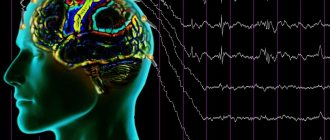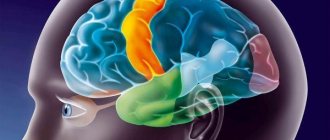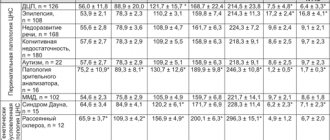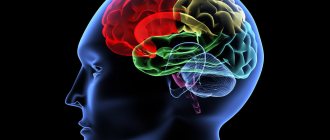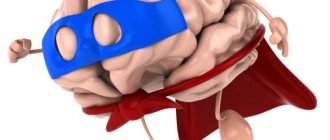EEG rhythms are diagnosable electrical oscillations of the brain. Different degrees of wakefulness are accompanied by changes in the frequency spectrum of EEG signals.
Depending on the amplitude, waveform, topography, frequency range and type of reaction, electroencephalography rhythms are distinguished.
The main EEG rhythms are denoted by Greek letters:
- ἄλφα (alpha);
- βήτα (beta);
- γάμμα (gamma);
- δέλτα (delta);
- θήτα (theta);
- κάππα (kappa);
- μυ (mu);
- σίγμα (sigma).
How does electroencephalography work?
Signal transmission in the human nervous system is carried out both chemically (using neurotransmitters) and electrically (action potentials). A single action potential or membrane voltage of a single neuron is too weak to be detected by non-invasive diagnostic methods. However, electrodes can detect the summation of synchronously occurring action potentials and make fluctuations in electrical activity visible.
There is a certain connection between a person’s mental state and EEG waves. Abnormalities or unusual brain waves may indicate pathology. A neurologist analyzes and describes such waves.
The electrodes measure activity in parts of the cerebral cortex that have a high density of nerve cells. However, an EEG measures not only the electrical potential of nerve cells in the brain, but also the muscles of the head and skin. Accordingly, fundamental EEG rhythms do not reflect precise neuronal activity. EEG rhythms and their relationship with the functional state of the brain are the subject of controversy in the scientific community.
Delta rhythms
EEG delta rhythms have a low frequency ranging from 0.1 to <4 Hz. Delta waves are typical functional waves of the deep, dreamless sleep phases. In infants, the delta rhythm is also present upon awakening.
Theta waves
Theta wave is a slow rhythm in the frequency range from 4 to <8 Hz. They are more common during drowsiness and dozing. EEG rhythms and their characteristics depend on the patient’s age. They are present in the waking state in children, but presence in adults may indicate brain dysfunction or damage.
Alpha waves
The normal alpha rhythm on the EEG has the following features:
- frequency 8-12 Hz: the lower limit of normal alpha rhythm in adults and children over 8 years of age is 8 Hz;
- location: occipital regions;
- morphology: rhythmic and regular;
- amplitude: usually 20-100 mV;
- reactivity: appears when the eyes are closed and disappears when they open.
Beta waves
The normal EEG beta rhythm has the following characteristics:
- Frequency (by definition) greater than 13 Hz.
- Location: diffuse distribution.
- Morphology: usually rhythmic and symmetrical.
- Amplitude: range 5-20 mV.
Reactivity: Beta activity increases during the first and second stages of sleep, and decreases in the deep phases. Central beta activity may be reactive to voluntary movements and proprioceptive stimuli.
Gamma waves
A gamma wave is a signal in the frequency range above 30 Hz. This rhythm occurs during strong concentration, during study or meditation. Recent studies have shown that the occurrence of gamma rhythms is necessary for the integration of various stimuli.
It should be noted that gamma rhythms are not visible on the EEG strip with the naked eye.
Ways to stimulate alpha waves
On the EEG, alpha rhythms can be observed only in cases when the human body is completely relaxed. Those observed in this state are distracted from problems, so stress is relieved. A slowdown in mental activity has also been noticed, so the consciousness is “cleared”. This allows you to create new ideas, increases the creativity of mental activity, and gets rid of the creative crisis.
If a person experiences severe and prolonged brain activity for some time, then the normal activity of the organ stops. The solution to this problem is to increase alpha waves and relieve mental stress.
There are many techniques that allow you to have a stimulating effect on alpha waves:
- Sound waves. A simple and accessible technique in all respects, with the help of which alpha activity increases, and the process itself brings a “dose of pleasure” to a person. The technique consists of listening to special music, which consists of stereo sounds.
- Yoga. Long-term yoga exercises, provided the exercises are performed correctly, act as a powerful activator of alpha activity in the brain, which can moderately and not dramatically increase the necessary indicators.
- Meditation. With the help of meditation, you can teach your body to relax automatically, but this will require spending a lot of time going through a huge number of practical sessions.
- Breathing exercises. The method implies that the person will have to constantly maintain deep breathing. This process saturates the brain cells and internal organs with oxygen. If you do breathing exercises systematically so that it becomes a habit, the creation of alpha waves will occur automatically.
- Hot baths. Relaxation almost always occurs after taking a hot bath, which also eliminates fatigue. The production of alpha waves is the main reason for the relaxation of muscle structures.
- Alcohol. Not a recommended method, which, oddly enough, also allows you to activate production and get an increased level of alpha waves. Alcohol is used by many people to relieve stress. Immediately after drinking alcohol, alpha waves begin to form, which allows a person to enter a state of relaxation, detachment from the world and relaxation.
Make your own choice
Most of the information - traumatic experiences, messages from significant adults - bypasses our consciousness and ends up at the unconscious level. This level has a huge influence on us, often even controls our lives. The more a person studies his unconscious and preconscious and transfers information to a conscious level, the more choices he has.
So, the daughter of an alcoholic, on a conscious level, is looking for a teetotaler as a husband, but her entire unconscious is literally permeated with information that a woman should devote herself to a man, save him, that she is not worthy of a healthy relationship. This is most likely how her mother or grandmother behaved. And she didn’t see any other scenario. Daughters of alcoholics in more than 50% of cases marry alcoholics (V. Moskalenko. Addiction: a family disease).
If this woman had been aware of her unconscious processes and learned how to interact more constructively with men, she would have had a better chance of finding a healthy partner. Until that happens, she has no choice.
Responsible waves
Contact with one's unconscious makes a person more conscious, more developed. Anna Wise wrote in her book that beta waves, which are responsible for the conscious thought process, do not provide full consciousness.
A person who has a predominance of beta waves and not enough other waves is cut off from his subconscious, which reduces his creative potential. An active state of consciousness is impossible without intuition and connection with the subconscious.
Beta waves
are responsible for the conscious thought process, the state of wakefulness. If there are too many of them, and there are few other waves, a person may experience causeless anxiety, perhaps even panic.
Alpha waves
provide a connection between conscious thinking and the subconscious. Even if there are waves responsible for the subconscious, but there are not enough alpha waves, a person may feel anxious. There is material from the subconscious that is ready to rise to the surface, but there is no connection with it. Alpha waves provide a calm state. Knowing how to relax is a very important skill for our health - both mental and physical.
A sign of a lack of alpha waves can be, for example, difficulties with remembering dreams or the ability to relax. Often, blockade of alpha waves occurs in situations where material that a person is not able to bear at the moment is repressed into the subconscious. If this pattern of blocking alpha waves is habitual, a person is practically cut off from his unconscious, which undoubtedly impoverishes his life.
The state of meditation is one in which the intellect produces few beta waves and many alpha and theta waves.
Anna Weisz
Theta waves
Perhaps someone managed to get into a state of “insight”, suddenly the right solution was found or an understanding of something important came. Such a moment may be accompanied by a feeling of elation, even trembling. It is in such states that people write poetry. And it doesn’t matter whether the idea came for a new book, a scientific discovery, choreography for a dance, or a successful business plan. This is the work of theta waves. In order for the material to rise to the conscious level and be fixed there, having first passed through the unconscious and subconscious levels, stable alpha waves are needed.
Delta waves
represent the subconscious. According to Anna Weisz, delta waves both form the subconscious and are the radar of the intellect. With the help of these waves we are able to “scan” the space around us and other people. This is our interest in the world. Delta waves remain active at times when all other waves are absent, for example during sleep. People with a large amplitude of delta waves are said to have good intuition and sense of other people. This quality is necessary for people working in the field of helping professions: psychotherapists, doctors, consultants, etc. In order not to drown in the flow of information, the same psychotherapists learn to work and live with this quality. Whereas for people who are gifted with these waves, but do not understand what happens to them, such conditions can become real torment. It would be good for such people to learn to recognize information and “pass” it without delay, to distinguish between their own and other people’s feelings.
Regulating brain rhythms is the key to a more relaxed, holistic, creative state.
Beta waves, state of activity
They range from 14 to 30 Hz. Such waves are also called “fast”. They are always recorded by instruments when a person’s eyes are open and he is actively involved in the process of cognition or awareness of the external environment.
Also, these waves are associated with a state of increased attention, excitement or excitement, which is not realized. A more specific example would be a conversation between two people.
Subject to communication, the human brain operates in beta wave mode. In other words, what is common in such states is that a person is actively involved in the events and phenomena of the surrounding world.
A rather sad fact is that almost all modern residents of large cities and megacities are constantly in beta wave mode (except during sleep). The state of beta waves can be associated with the appearance of stress or a near-stress state.
Can Theta Waves Help Cope With Depression?
In the case of depression, it is important to understand that this is a diagnosis that refers to mental disorders. Only a doctor should treat her. If we are talking about apathy, loss of strength, bad mood, anxiety, panic attacks, then working with theta waves will be a good method of psychotherapy for a person. With the help of a specialist, he will quickly and effectively deal with his mental health. A professional working with the theta state of the brain will determine the true cause of certain events in your life, work through them at the subconscious level and help you find inner harmony.
